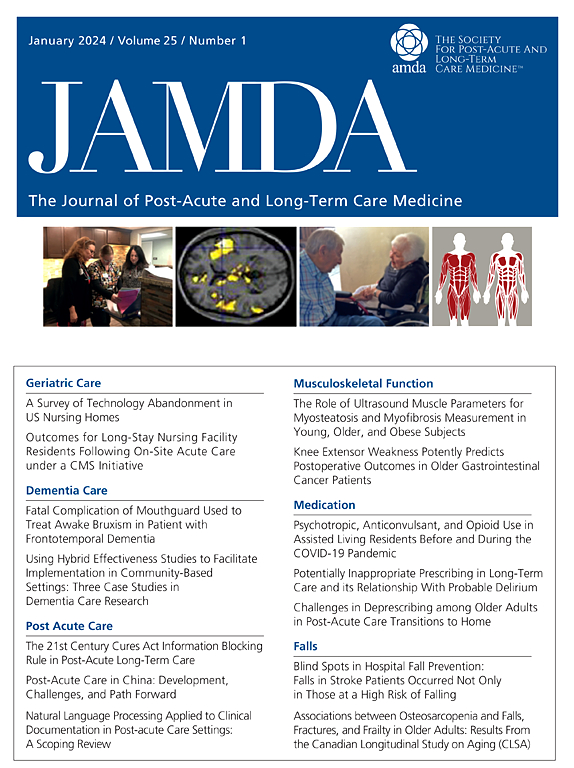Pattern of Antidiabetic Drug Prescription in Older Persons With Type 2 Diabetes: Results From the German DPV Registry
IF 3.8
2区 医学
Q2 GERIATRICS & GERONTOLOGY
Journal of the American Medical Directors Association
Pub Date : 2025-06-28
DOI:10.1016/j.jamda.2025.105724
引用次数: 0
Abstract
Objectives
To explore prescription patterns of SGLT2 inhibitors (SGLT2i) and GLP-1 receptor agonists (GLP-1RA) in older adults with type 2 diabetes (T2DM), analyzing age and sex differences.
Design
Observational retrospective study.
Setting and Participants
Data from 103,820 patients aged 60 to 90 years from 518 diabetes centers in Germany, collected between 2017 and 2022 via the DPV registry.
Methods
Patients with at least 3 months’ T2DM diagnosis were included. Treatment trends were analyzed using regression models adjusted for age and sex. Repeated measures were aggregated annually.
Results
Between 2017 and 2022, SGLT2i use rose from 7.3% to 27.4% and GLP-1RA use from 3.4% to 13.8%. Metformin use increased, while sulfonylureas declined. SGLT2i use was lower in women across all age groups. GLP-1RAs use increased more in younger patients.
Conclusions and Implications
Newer antidiabetic drugs are increasingly prescribed in older adults, but notable disparities by age and gender persist. These findings suggest the need to address potential biases and barriers to optimize equitable care in geriatric diabetes management.
老年2型糖尿病患者的抗糖尿病药物处方模式:来自德国DPV登记的结果。
目的:探讨SGLT2抑制剂(SGLT2i)和GLP-1受体激动剂(GLP-1RA)在老年2型糖尿病(T2DM)患者中的处方模式,分析年龄和性别差异。设计:观察性回顾性研究。环境和参与者:来自德国518个糖尿病中心的103820名60至90岁患者的数据,于2017年至2022年通过DPV登记处收集。方法:纳入确诊T2DM至少3个月的患者。使用年龄和性别调整后的回归模型分析治疗趋势。重复测量每年汇总。结果:在2017年至2022年期间,SGLT2i的使用率从7.3%上升到27.4%,GLP-1RA的使用率从3.4%上升到13.8%。二甲双胍的使用增加,而磺脲类药物的使用减少。SGLT2i的使用在所有年龄组的女性中都较低。GLP-1RAs的使用在年轻患者中增加更多。结论和意义:老年人越来越多地使用新型降糖药,但年龄和性别之间的显著差异仍然存在。这些发现表明,需要解决潜在的偏见和障碍,以优化老年糖尿病管理中的公平护理。
本文章由计算机程序翻译,如有差异,请以英文原文为准。
求助全文
约1分钟内获得全文
求助全文
来源期刊
CiteScore
11.10
自引率
6.60%
发文量
472
审稿时长
44 days
期刊介绍:
JAMDA, the official journal of AMDA - The Society for Post-Acute and Long-Term Care Medicine, is a leading peer-reviewed publication that offers practical information and research geared towards healthcare professionals in the post-acute and long-term care fields. It is also a valuable resource for policy-makers, organizational leaders, educators, and advocates.
The journal provides essential information for various healthcare professionals such as medical directors, attending physicians, nurses, consultant pharmacists, geriatric psychiatrists, nurse practitioners, physician assistants, physical and occupational therapists, social workers, and others involved in providing, overseeing, and promoting quality

 求助内容:
求助内容: 应助结果提醒方式:
应助结果提醒方式:


